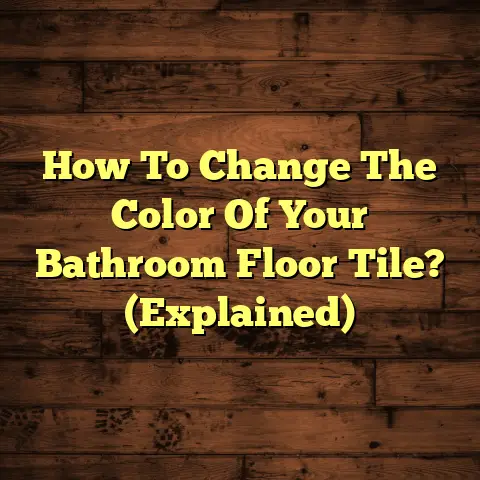Laminate Flooring in Somerset West Homes? (3 Subfloor Sins!)
Ever dreamt of beautiful, durable floors without breaking the bank?
Laminate flooring is often the answer, but let’s be real, there are myths galore about its durability.
These myths can lead to some serious flooring faux pas!
I’m here to spill the tea – the real, unvarnished truth about laminate, and more importantly, the subfloor sins that can turn your flooring dreams into a nightmare.
I’ve seen it all in my years as a flooring contractor in this beautiful corner of the world.
So, grab a cuppa, and let’s dive in!
Understanding Laminate Flooring
So, what is laminate flooring, anyway?
It’s not just a cheap imitation of wood.
It’s a carefully engineered product with several layers, each playing a crucial role.
-
Wear Layer: This is the top dog, the surface you walk on.
It’s a clear, protective layer that resists scratches, stains, and fading.
-
Design Layer: This is where the magic happens – a high-resolution photographic image of wood, stone, or tile.
It’s what gives laminate its realistic look.
-
Core Layer: This is the heart of the laminate, usually made of high-density fiberboard (HDF) or medium-density fiberboard (MDF).
It provides stability and impact resistance.
-
Backing Layer: The foundation, this layer provides balance and helps prevent moisture from seeping into the core.
The manufacturing process is pretty cool.
The layers are fused together under high heat and pressure, creating a durable and stable plank.
Think of it like a super-strong sandwich!
What’s so great about laminate?
Well, it’s affordable, easy to install (DIY-friendly!), and comes in a dizzying array of designs.
You can get the look of expensive hardwood or exotic stone without the hefty price tag.
Common Durability Myths
Now, let’s bust some myths!
I hear these all the time, and it’s time to set the record straight.
Myth 1: Laminate Flooring is the
Same as Real Wood Flooring
Nope!
While laminate can mimic the look of wood remarkably well, it’s a different beast altogether.
Hardwood is, well, wood.
It’s solid, can be refinished multiple times, and has a natural warmth and character.
Laminate, on the other hand, is a synthetic product.
It’s generally more scratch-resistant than hardwood but can’t be refinished.
If you scratch hardwood, you can sand it and re-stain it.
If you scratch laminate, you will have to replace the plank.
Hardwood is definitely more luxurious.
Here’s a quick comparison:
| Feature | Hardwood | Laminate |
|---|---|---|
| Material | Solid Wood | Engineered Layers |
| Refinishable | Yes | No |
| Scratch Resistance | Lower | Higher |
| Cost | Higher | Lower |
| Maintenance | More Demanding | Easier |
Myth 2: Laminate Flooring is Prone to
Scratches and Damage
This one’s partially true, but modern laminate flooring has come a long way.
The wear layer is the key here.
It’s rated using an “AC” (Abrasion Class) rating, from AC1 to AC5.
Higher AC ratings mean greater scratch and wear resistance.
For a busy household with kids and pets, I always recommend AC4 or AC5 rated laminate.
It can handle a beating!
There are also textured laminates that hide scratches more effectively.
Myth 3: Laminate Flooring Will Warp
in Humid Conditions
Ah, the humidity question!
Somerset West can get pretty muggy, especially during the summer months.
Older laminate flooring was susceptible to warping in humid environments.
But modern laminates are designed to be more moisture-resistant.
The core layer is often treated to repel water, and the backing layer provides an additional barrier.
However, proper installation is crucial.
Gaps around the perimeter of the room allow for expansion and contraction, preventing buckling.
Also, a good quality underlayment can provide an extra layer of moisture protection.
The Role of the Subfloor in Laminate
Flooring Durability
Okay, let’s talk about the unsung hero of any successful laminate flooring installation: the subfloor.
The subfloor is the foundation upon which your laminate rests.
It’s typically made of concrete or plywood, and its job is to provide a stable, level, and dry surface.
Think of it like this: your laminate flooring is a beautiful cake, and the subfloor is the cake stand.
If the cake stand is wobbly or uneven, the cake will topple!
An improperly prepared subfloor can lead to a whole host of problems, including:
-
Warping: Moisture seeping into the laminate causes the core to swell, leading to warping.
-
Buckling: Uneven surfaces create stress points, causing the laminate to buckle and lift.
-
Gaps: An uneven subfloor can result in unsightly gaps between the laminate planks.
-
Premature Wear: Constant movement and flexing can wear down the laminate prematurely.
The 3 Subfloor Sins
Alright, time to confess!
These are the three biggest subfloor sins I see homeowners commit when installing laminate flooring.
Avoid these, and you’ll be well on your way to a beautiful and long-lasting floor.
Sin 1: Ignoring Moisture Issues
Moisture is the enemy of laminate!
Before you even think about laying down that first plank, you must assess the moisture levels in your subfloor.
Concrete subfloors are particularly prone to moisture issues.
Concrete is porous, and moisture can wick up from the ground.
Plywood subfloors can also absorb moisture from leaks or spills.
How do you check for moisture?
I use a moisture meter.
These handy devices measure the moisture content of the subfloor.
For concrete, you want a reading below 4.5%.
For plywood, aim for below 12%.
You can rent moisture meters from most hardware stores.
If you find high moisture levels, you’ll need to address the problem before installing your laminate.
This might involve:
-
Installing a moisture barrier: A plastic sheet placed between the subfloor and the underlayment.
-
Repairing leaks: Fixing any plumbing or roof leaks that are contributing to the moisture problem.
-
Improving ventilation: Ensuring adequate ventilation in the crawl space or basement.
Ignoring moisture issues is like building a house on a swamp.
It’s a recipe for disaster!
Sin 2: Installing Over an Uneven Subfloor
An uneven subfloor is another major no-no.
Laminate flooring needs a smooth, level surface to perform properly.
Even small dips and bumps can cause problems down the road.
How do you check for unevenness?
Grab a long straightedge (at least 6 feet long) and a level.
Place the straightedge on the subfloor and use the level to check for any gaps or dips.
I also like to run my hand over the surface to feel for any imperfections.
According to the American Society for Testing and Materials (ASTM), the subfloor should be flat to within 3/16 inch over a 10-foot span.
If you find areas that are out of level, you’ll need to correct them.
This might involve:
-
Using a self-leveling compound: This is a liquid mixture that you pour onto the subfloor.
It spreads out and levels itself, creating a smooth, even surface.
-
Sanding down high spots: If you have small bumps or ridges, you can sand them down with a floor sander.
-
Adding shims: For small dips, you can use shims to level the subfloor.
Trying to install laminate over an uneven subfloor is like trying to build a house on a hill without leveling the ground.
It’s just not going to work!
Sin 3: Failing to Use Underlayment
Underlayment is a thin layer of material that goes between the subfloor and the laminate flooring.
It’s often overlooked, but it plays a vital role in the performance of your floor.
Underlayment provides several benefits:
-
Sound Absorption: It helps to muffle noise, making your floor quieter to walk on.
-
Thermal Insulation: It adds a layer of insulation, helping to keep your home warmer in the winter and cooler in the summer.
-
Moisture Protection: It provides an extra barrier against moisture, helping to protect your laminate from warping.
-
Cushioning: It adds a bit of cushion underfoot, making your floor more comfortable to walk on.
There are many different types of underlayment available, including foam, cork, and rubber.
The best type for you will depend on your specific needs and budget.
If you’re installing laminate over a concrete subfloor, I recommend using an underlayment with a built-in moisture barrier.
Failing to use underlayment is like skipping the frosting on a cake.
It might still taste good, but it’s not going to be as enjoyable!
Conclusion
So, there you have it!
The truth about laminate flooring durability and the three subfloor sins that can sabotage your flooring project.
Remember, laminate flooring can be a durable and beautiful option for your Somerset West home.
But it’s essential to understand the facts, avoid the myths, and pay attention to the subfloor.
By addressing moisture issues, leveling the subfloor, and using underlayment, you can ensure that your laminate flooring will last for years to come.
Don’t let these subfloor sins ruin your flooring dreams!
Take the time to prepare your subfloor properly, and you’ll be rewarded with a beautiful and long-lasting floor that you can enjoy for years to come.
Happy flooring!





